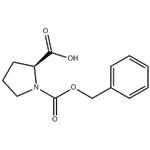- Cbz-L-Pro-OH
-

- $0.00/ kg
-
2024-11-04
- CAS:1148-11-4
- Min. Order: 1kg
- Purity: 98%
- Supply Ability: 1T
|
| | N-Benzyloxycarbonyl-L-proline Basic information |
| | N-Benzyloxycarbonyl-L-proline Chemical Properties |
| Melting point | 75-77 °C | | alpha | -60 º (c=2,AcOH) | | Boiling point | 392.36°C (rough estimate) | | density | 1.1952 (rough estimate) | | refractive index | -40 ° (C=2, EtOH) | | storage temp. | Sealed in dry,Room Temperature | | solubility | Solubility in methanol, almost transparency. | | form | Crystalline Powder or Crystals | | pka | 3.99±0.20(Predicted) | | color | White to off-white | | optical activity | [α]20/D 42°, c = 2 in ethanol | | BRN | 88579 | | InChIKey | JXGVXCZADZNAMJ-NSHDSACASA-N | | CAS DataBase Reference | 1148-11-4(CAS DataBase Reference) |
| | N-Benzyloxycarbonyl-L-proline Usage And Synthesis |
| Chemical Properties | white to light yellow crystal powder | | Uses | N-(Benzyloxycarbonyl)-L-proline is a potent in vitro and in vivo inhibitor of prolidase; a specific peptidase that cleaves dipeptides with a C-terminal prolyl and hydroxylprolyl residue. It is also used in the synthesis of N-(L-Prolyl)-β-alanine which is a derivative of the naturally occurring beta amino acid β-Alanine. | | Preparation | Caution! All procedures must be carried out in an efficient fume cupboard, wearing latex gloves and chemical-proof safety goggles. ι-Proline (10.0 g, 8.7 mmol) was dissolved in 2 m sodium hydroxide solution (40 mL), and the solution was cooled to ice-water temperature. Z-Cl (20.5 g, 12 mmol) was added portionwise, with vigorous stirring or occasional shaking, over a period of 30 min at 0–5 °C to the solution of l-proline. The ice bath was then removed and stirring or occasional shaking was continued for 30 min while the reaction mixture warmed to room temperature. The mixture was then acidified to Congo red by the gradual addition of concentrated hydrochloric acid, and the oil was extracted into ethyl acetate. The extract was dried over magnesium sulfate, the mixture was filtered, and the filtrate was concentrated in vacuo. The residue was extracted/triturated with warm tetrachloromethane. The washings were decanted and the residue was further purified by recrystallization from ethyl acetate/petroleum ether. |
| | N-Benzyloxycarbonyl-L-proline Preparation Products And Raw materials |
|